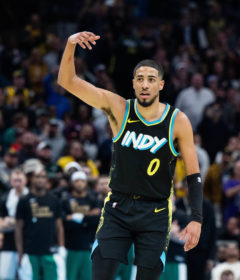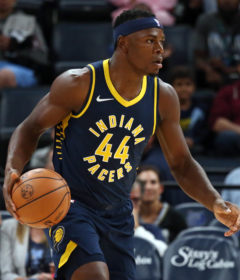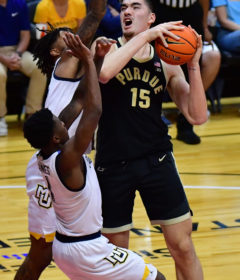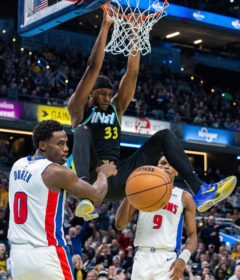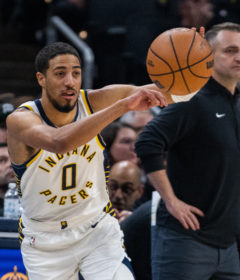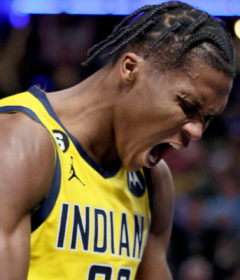Will Andrew Luck slip? Looking at all-time greats, Year 1 vs. Year 2
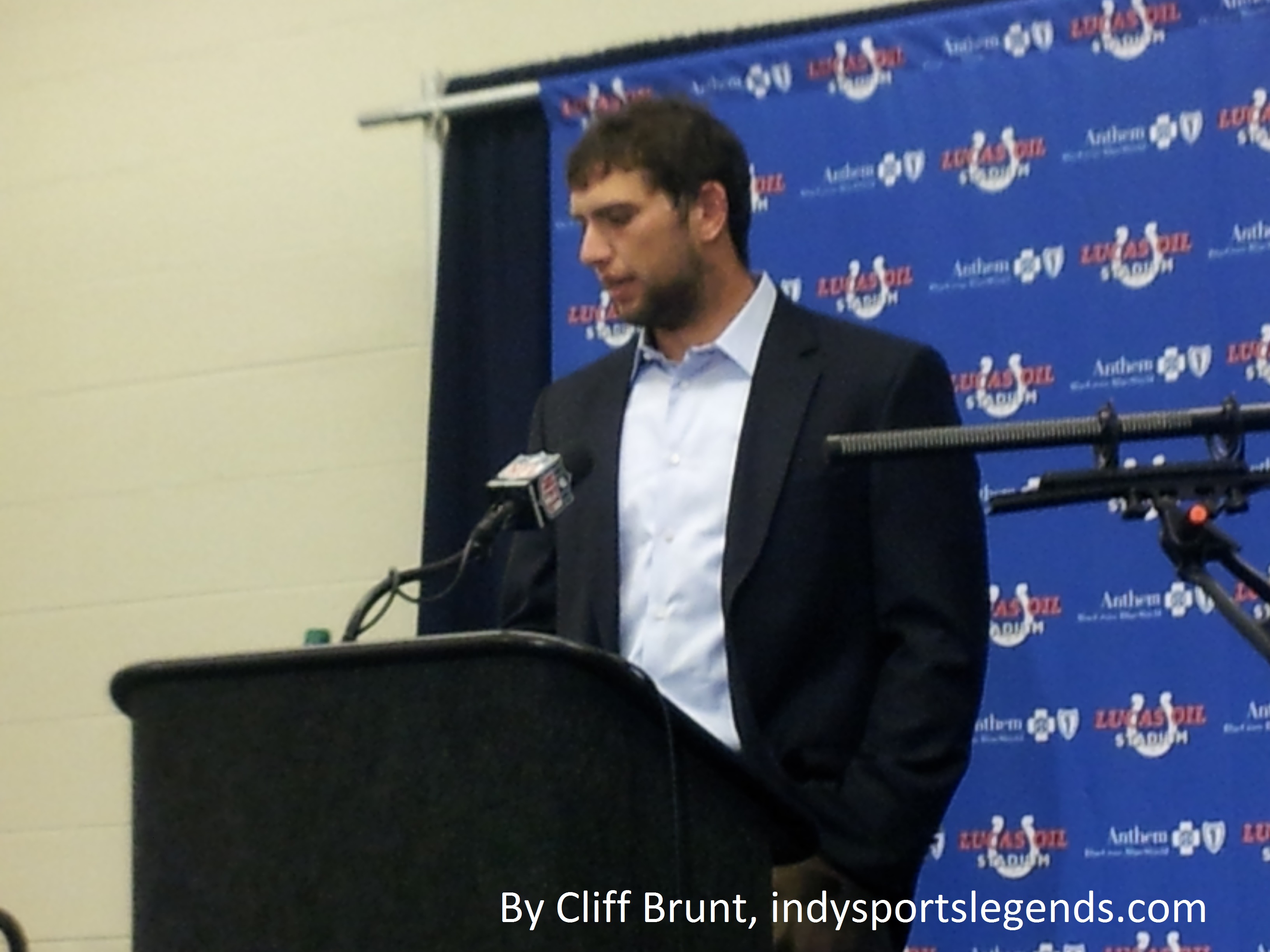
By CLIFF BRUNT
ISL Editor

As a recent radio guest on Fox Sports Radio’s Fantasy Freaks, I was asked if I thought Andrew Luck would face a sophomore slump. I said he’s too smart and too dedicated and too talented to slip.
Luck, I explained, is much more than a flash. Not only is he insanely athletic, he’s a student of the game. For him, it’s not about being a star, it’s about doing his job. That job is to win. Period. I’m not worried about him at all.
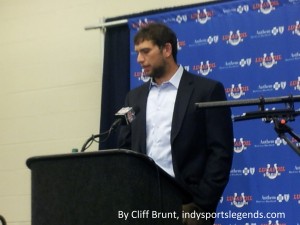
The question was a bit unexpected, but it makes sense, given the enormity of what Luck accomplished as a rookie.
What Luck did last season was amazing. He took a young team with unproven talent to the playoffs a year after it won two games. He did so by carrying the load and being the man from day one. He broke the rookie single game and season passing yardage records and went to the Pro Bowl. He threw for 4,374 yards, 23 touchdowns and 18 interceptions.
While Robert Griffin III’s accomplishments were exceptional, he had more proven talent around him than Luck. Griffin won the rookie-of-the-year award in large part because, though he was dynamic, the Redskins had a great running game to go with him, making his job easier. Washington’s running game was No. 1; Indy’s was No. 22.
Many folks don’t realize how rare what Luck, Griffin and Russell Wilson, accomplished last season really was. Most rookies simply don’t come in and succeed. Most don’t even play on a regular basis, even if they are good. Though it has become more common for rookies to start right away in recent years, Colin Karpernick and Kirk Cousins are more typical cases. Kaepernick threw a total of five passes as a rookie, but led his team to a Super Bowl title in his second year. Kirk Cousins, a talented rookie last year, is stuck behind RGIII.
Here’s a look back at Luck’s rookie year, courtesy of YouTube user Nicholas Genovese.
Still, the question remained: Could Luck fall off? With that question in mind, I go through the best quarterbacks in NFL history and look at how they fared as rookies versus their second year.
Because Luck is a rare talent who should be among the best ever if he stays healthy, this is a carefully crafted list. I took the top 20 players in NFL history in passing yardage, then eliminated those whose careers began before 1975 (Fran Tarkenton, Dan Fouts, Johnny Unitas, Jim Hart) so there would be some similarity in how the game is played. I then eliminated those whose pro careers didn’t start in the NFL because there would be a maturity difference in their rookie years in the NFL versus Luck’s (Warren Moon CFL, Jim Kelly USFL).
I then added four exceptions who are ranked below No. 20 — Phil Simms (24), Troy Aikman (27), Eli Manning (33) and Ben Roethlisberger (37) because they started their pro careers in the NFL, won Super Bowls and are in the Top 40 in passing yards.
I didn’t include two others who could have been exceptions. Though Steve Young won a Super Bowl, he is eliminated from this sample because he started his pro career with the USFL’s Los Angeles Express. Kurt Warner also won a Super Bowl, but he started his pro career in Arena Football.
First, I’ll list those who started for less than half the season as rookies but eventually became stars. Their all-time rank in career yards passing is in parentheses. You’ll be shocked at some of the people on this list.
Brett Favre (1)
Favre started his career in Atlanta and only threw four passes as a rookie in 1991. He went to Green Bay in 1992 and went 8-5 as a starter. He threw for 3,227 yards, 18 touchdowns and 13 interceptions.
Vinny Testaverde (7)
Testaverde started just four games as a rookie for the Tampa Bay Buccaneers in 1987 — and lost them all. His second year, he was 5-10 as a starter. He threw 13 touchdown passes and a startling 35 interceptions in year two. He really didn’t hit his stride until he reached his 30s, but was very successful in Cleveland, Baltimore and with the New York Jets.
Drew Brees (8)
Brees threw just 27 passes as a rookie in 2001. He won the starting job over Doug Flutie his second year, passed for 3,284 yards with 17 touchdowns and 16 interceptions and led San Diego to an 8-8 record.
Tom Brady (9)
Brady threw three passes as a rookie. He entered his second year as a backup to Drew Bledsoe, but Bledsoe got hurt and Brady led the team to the playoffs. Brady was injured in the 2001 AFC Championship Game and Bledsoe got the Patriots to the Super Bowl. Brady led the way in the Super Bowl, a dramatic comeback win over the St. Louis Rams.
Joe Montana (13)
Joe Montana threw 23 passes as a rookie behind Steve DeBerg, and went 2-5 as a starter his second year. He won the Super Bowl in year three.
Dave Krieg (15)
Krieg, an undrafted free agent who attended Milton College, was stuck behind Jim Zorn on the depth chart and didn’t become a full-time starter until his fifth season.
Boomer Esiason (16)
Esiason started just four games as a rookie (3-1), but he won the starting job over the legendary Ken Anderson his second year and led the Bengals to a 7-7 mark as a starter. He threw for 3,443 yards, 27 touchdowns and just 12 interceptions in year two.
Donovan McNabb (17)
McNabb wasn’t the full time starter as a rookie in 1999. He went 2-4 in his starts, completed just 49 percent of his passes and threw eight touchdowns and seven interceptions.
His second year, he went 11-5 as a starter, went to the Pro Bowl and was second in the league MVP balloting. He threw for 3,365 yards, 21 touchdowns and 13 interceptions and ran for 629 yards, the fourth-highest total in a season for a quarterback at the time.
Jim Everett (19)
Everett started just five games as a rookie in 1986, but he started 11 in his second year. He went 5-6 as a starter in 1987. His big jump came in his third year, when he passed for 3,964 yards, led the NFL with 31 touchdown passes and guided the Rams to the playoffs.
Phil Simms (24)
Simms is the only one on this list who statistically regressed in his second year. He was 6-5 as a starter in 1979, even though he was unspectacular. His completion percentage dipped below 50 percent in year two, and he threw 19 interceptions to 15 touchdowns. He really didn’t get it going on an elite level until year five, at age 30, and the interception bug plagued him well into the second half of his career. He eventually became very efficient and was MVP of Super Bowl XXI.
Eli Manning (33)
Manning went 1-6 as a starter his rookie year and completed just 48 percent of his passes with six touchdowns and nine interceptions. His second year, he led the Giants to an 11-5 record and a playoff berth. He threw for 3,762 yards with 24 touchdowns and just 17 interceptions.
__
As you can see, many of the NFL’s very best passers of all time did little their rookie seasons. Now, do you understand how impressive Luck was last season?
Most of those guys improved in year two, but not as much as the people on the next list.
And now, here are the guys who played significantly as rookies, and their comparisons to year two. These are the best players to use in projecting Luck’s growth.
Dan Marino (2)
Marino replaced David Woodley in Week 6 of his rookie year and ended up in the Pro Bowl. His second year, he threw for 5,084 yards and 48 touchdowns, records that stood for at least 20 years, and he led the Miami Dolphins to the Super Bowl.
Peyton Manning (3)
As a rookie, Manning passed for 3,739 yards with 26 touchdowns and 28 interceptions, and the Colts went 3-13. In his second year, he threw for 4,135 yards, 26 scores and just 15 picks. His completion percentage jumped from 56.7 percent to 62.1 percent. The Colts went 13-3 and Manning went to the Pro Bowl.
John Elway (4)
Elway went 4-6 as a rookie starter, but improved to 12-2 his second year and led the Broncos to the playoffs. As a rookie, he threw seven touchdowns and 14 interceptions; in his second year, he threw 18 touchdowns and 15 interceptions.
Drew Bledsoe (10)
Bledsoe went 5-7 as a rookie starter, but went 10-6 his second year and led the NFL with 4,555 yards. Though he threw 27 interceptions, he also fired 25 touchdown passes and went to the Pro Bowl.
Kerry Collins (12)
Collins went 7-6 as a rookie for Carolina and completed less than half his passes. His second year, the Panthers went 9-3 in his starts and led the Panthers to the NFC Championship Game. As a rookie, he threw 14 touchdown passes and 19 interceptions; the next year, he threw 14 touchdowns tosses and just nine interceptions.
Troy Aikman (27)
Troy Aikman went 0-11 as a starter but went 7-8 as a starter his second year. He made the Pro Bowl in year three and won the Super Bowl in year four.
Ben Roethlisberger (37)
Ben Roethlisberger opened training camp as Pittsburgh’s No. 3 quarterback, but he eventually took the starting job from Tommy Maddox and led the Steelers to the AFC Championship Game. He was 13-0 as a rookie starter and was the AP Offensive Rookie of the Year. His second year, he was 9-3 in the regular season, then won the Super Bowl to become the yougest quarterback to reach the top.
This list is startling, and shows what happens when a supreme talent gets to play early on. Most of these guys were solid as rookies but did amazing things in year two. Many of them won Super Bowls, went to Pro Bowls, set records or turned franchises around in their second year.
Luck did most of those things in year one. His career at this point looks most similar to Marino’s in that he carried the load on a passing team as a rookie and went to the playoffs and the Pro Bowl. If Marino’s second year is an indicator, this will be a special year in Indianapolis. History shows that among the quarterbacks in situations most similar to Luck’s, year two is significantly better, and usually dynamite.
Sophomore slump? I think not.

